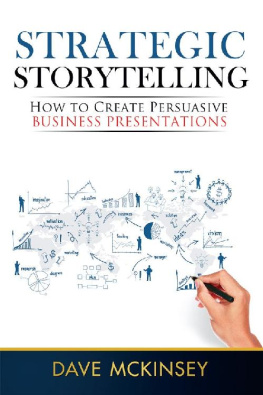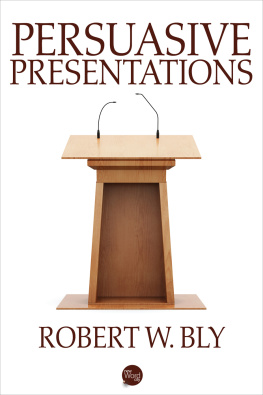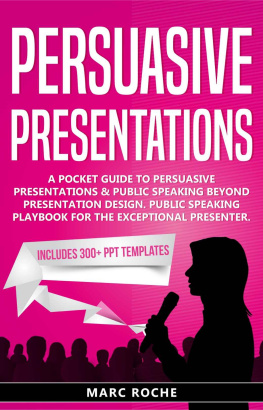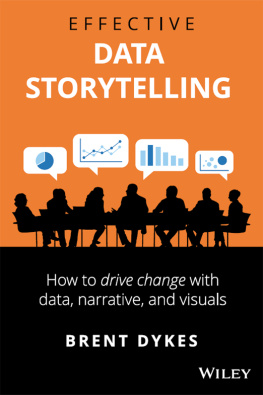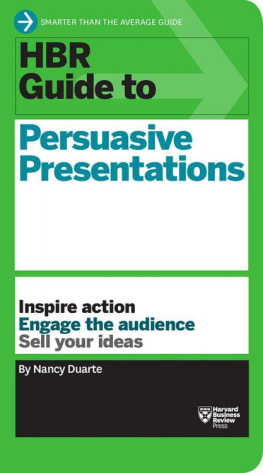Strategic
Storytelling
How to Create Persuasive
Business Presentations
Dave McKinsey
Copyright 2014 by SpeakingSherpa LLC. All rights reserved. Except as permitted under the United States Copyright Act of 1976, no part of this publication may be reproduced or distributed in any form or by any means, or stored in a database or retrieval system, without the prior written permission of the author.
In adherence with the fair use rule of United States copyright law, this book makes use of materials owned by the United States Postal Service and created by McKinsey & Company, Accenture, and The Boston Consulting Group for the purpose of criticism and commentary and for the purpose of providing a public good by elevating the presentation skills of business professionals. Though I have no direct affiliation with any of these organizations, it is my hope that this book significantly increases the number of people exposed to these organizations and their best practices. All company and product names mentioned herein are the trademarks or registered trademarks of their respective owners.
ISBN: 1500594466
ISBN-13: 978-1500594466
CreateSpace Independent Publishing Platform
North Charleston, South Carolina
Contents
Introduction
When I look at the public speaking books piled high on my bookshelf, I notice two patterns and one major gap.
The first pattern is that most public speaking books focus on keynote content and delivery. While there is no strict definition, keynote speeches are highly rehearsed, one-way, motivational, and delivered while standing on a podium in front of an unfamiliar audience. TED Talks and Toastmasters speeches, presentation types on which I have written books, fall into this category.
The second pattern is that presentation design books also fall into the keynote speech category. Two of my favorite authors, Garr Reynolds and Nancy Duarte, set the gold standard for how to craft beautiful presentations. If you have not already, devour everything they have written.
The motivation for focusing on keynotes is compelling: Keynotes are complex, nerve-wracking presentations. Many believe you can excel in any speaking situation if you can deliver an exceptional keynote. However, this logic is flawed.
The truth is that most presentations are delivered at work in seemingly low stakes situations in the hallway, in one-on-one discussions, and in small group meetings. They are (most of the time) lightly rehearsed, two-way, fact-laden, and delivered while sitting down to a very familiar audience. In short, they are precisely the opposite of keynote speeches.
But, arent there plenty of books on public speaking at work? Yes and no. The issue is that business-centric public speaking books, as valuable as they have been to me, are often rather academic. Excellent examples covering content and delivery include Stephen Lucass The Art of Public Speaking and Barbara Mintos The Minto Pyramid Principle. Excellent examples covering design include Gene Zelaznys classic Say It with Charts and Stephen Fews essential Show Me the Numbers.
So, what is the gap I observe while staring at my bookshelf? I want to read a public speaking book that is about the real speaking situations in which I find myself at work every day. I want to read a public speaking book that is entertaining. I want to read a public speaking book that integrates content, design, and delivery. And, finally, I want to read a public speaking book steeped in the principles of storytelling, the most in-demand skill in business today.
I have wondered why this sort of book does not already exist or at least why I have yet to find one. Here is the best explanation I could conceive: In contrast to a multitude of keynotes readily accessible on YouTube, examples of exceptional business presentations, especially ones that are legal to reproduce, are nearly impossible to find in the public domain. For instance, legend has it that Steve Jobs, upon his return to Apple in 1997, went to a whiteboard and drew a simple two-by-two grid. The rows were labeled Desktop and Portable and the columns Consumer and Professional. That meeting transformed a company suffering under the crushing weight of over 300 products. The underlying philosophy of minimalism now defines everything the company does. Since that meeting was not recorded, we have no idea who was in the room, how the meeting was structured, or how people interacted. Those types of meetings are highly confidential and companies only talk about them (with rose colored glasses) years later, if ever.
Besides geeking-out on public speaking for the past two decades, I have also worked my way up the ladder to become a senior executive in a company with nearly $2 billion in revenue; I craft and I critique high-stakes business presentations every day. Since I cannot release my employers material, non-public presentations, I considered a few options when I decided to author this book. First, I tried to write a fictionalized tale of a new product manager introducing an electronic healthcare device in the business parable style of Patrick Lencionis The Five Dysfunctions of a Team or Eliyahu Goldratts The Goal. However, I found myself repeatedly violating the storytelling maxim that exposition should always be the subtext of interaction between characters and never straight explanation. Fiction, or at least my fiction, was simply too contrived and inefficient to explore persuasive business storytelling.
When that attempt failed, I asked myself: Where do the most compelling strategy presentations come from? The answer, of course, is from top tier management consulting firms. I struck gold when I realized that these firms are often required to release their presentations when they serve public institutions. The gold mine turned to a diamond mine when I found an engagement that involved not one, but three of the top ten consulting firms McKinsey & Company, The Boston Consulting Group, and Accenture.
In , I cover verbal and non-verbal delivery principles that convey authority and authenticity in business settings.
With this backdrop, lets get started.
Chapter 1
The Perfect Storm
Sometime during the evening of January 26, 2009, a light freezing drizzle began to fall in central Kentucky. Over the course of the next two days, as the storms reach broadened across the state, the drizzle turned to rain, the rain to sleet, the sleet to snow, and the snow to ice. When the storm was over, 609,000 homes and businesses were left without power and 35 Kentucky residents had lost their lives.
Among the towns hardest hit was tiny Lowes, Kentucky which lost telephone, Internet, and electricity service for three weeks. Supporting a population of merely 98 residents, Postmaster JoAnn Bell and her Postmaster Relief Becky Goin understandably could have suspended mail delivery service to tend to their own urgent needs. After all, more than 200 Post Offices were impacted across Kentucky. However, Joann and Becky kept their 137-year-old post office running by relying on very old-school technology including a vintage fan scale, a battery-powered adding machine, and an old-fashioned gas stove.completion of their appointed rounds in their minds as they skated their way through their delivery routes.
As the 2009 ice storm released its grip on the Central Plains and Midwestern United States, a perfect storm was forming that would affect all 36,496 retail post offices with their 623,128 employees. Some of the clouds on the horizon had been visible as macro-trends for years. The double whammy of an aging workforce and increased healthcare costs was putting a burden on retirement obligations. Additionally, the Internet had long since relegated the traditional mailbox to a repository for junk mail, bills, and birthday cards.
Next page
